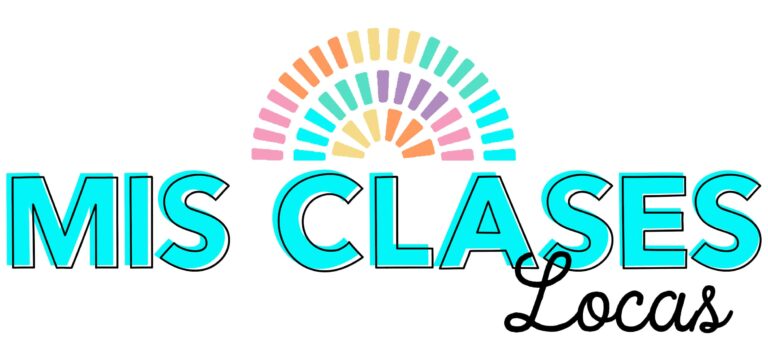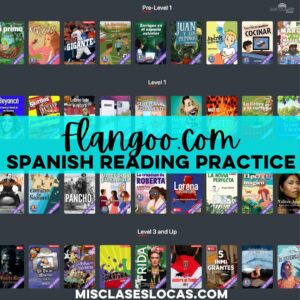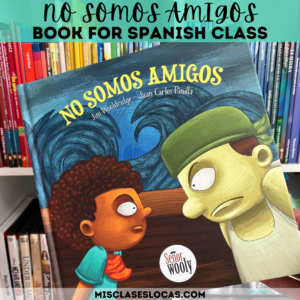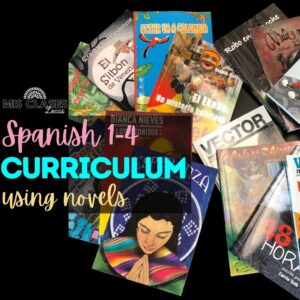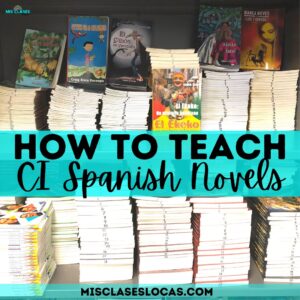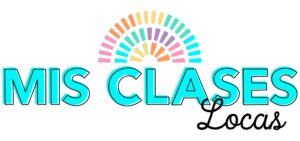Differentiated Reading Groups in Spanish Class
After observing 2nd grade I was firmly convinced that I needed to try something different. After seeing amazing literacy differentiation in person, I figured it was time to try it myself with “that class.” I have one level one class, in particular, that has a WIDE range of personalities and reading levels. It also has a para educator, and for the month, an instructional coach. Yet, I was not utilizing these other individuals to their full potential because neither of them speak Spanish.
After my observation, I remembered a series of blog posts from the amazing Carrie Toth about her reading clubs. (Check them out and then come back: Reading Club – overview, Reading Club – Discussion Day and Reading Club Takeaways).
Now that you have soaked up her wisdom, here is my (in progress) take on reading clubs in Spanish class.

Spanish Reading Club
Our last novel of Spanish 1 this year is Peter va a Colombia by Craig Klein of Spanish Cuentos. You can see our full curriculum this year in this post, but we have already read the novels Tumba & Brandon Brown Quiere un Perro as a class.
I know that having separate groups would be great for upper levels, and knew that I was taking a chance by trying it with level one. I probably would not have had the guts to try it without the support of my instructional coach, who was currently in this class for the very reason that I needed more assistance with this particular group. You can see how I have done literature circles with multiple novels in upper-level classes in this post. You can see chapter by chapter ideas for the novel in this post.
Starting Spanish Reading Club
To start, students took this reading club survey adapted from Carrie Toth. I used these to separate students into three groups: Individual, Cooperative, and Alpha (who read with me). Overall the students were very intuitive and made great choices for their groups. I did talk to a student with an IEP who wanted to be in the individual but is a much better-fit reading with me. We started with five individuals, six cooperatives (which I split into two groups of three), and nine with me. These groups are not set in stone and I have tried to provide flexibility, especially concerning the group with me. I want every student to feel confident and successful in reading.
Prep for Reading Clubs
As for prep work for me, I made my large slide show with vocabulary, discussion questions and activities by chapter. These were posted on Schoology, so everyone had access to them with their Chrome books. This saved me a ton of copies and day to day prep. For logistics, I am keeping everyone on the same chapters. We spent two days on the first, but most others we are doing about a chapter per day. Each day as a full group I explain our goals for the day, as well as write them on the board, and then set everyone free in their groups.
Example of a plan for the day:
Ch3 Vocab – come up with a mini-story to use in context
Read Ch3 (Ind – on own, Coop – in groups, Alpha – I read)
Ch3 – activities (Ind – answer questions & predict, Coop – create storyboard & retell, Alpha – I lead)
Sometimes we complete an activity as a class, before breaking into our groups for the day. This helps me to see how everyone is doing. It also keeps our classroom community strong, instead of always being seperated. Some examples of all class activities we have completed are Running Dictation, Reader’s Theater performance (from the cooperative and alpha groups), Quizlet Live vocabulary introduction, or discussion circles. Once we finish the novel I plan to blog about specific activities we completed for each chapter.
I also later realized that I needed some back up, fast finisher activities that could be completed with any chapter in case groups were done early. You can see this list posted on the board in the picture below.
Reading Club – Grupo Individual

The individual group is made up of five high flyers. These are all students who like to read at their own (usually fast) pace. A few of the individuals tend to sit together and occasionally use each other for questions and support. They usually all read on their own, and sometimes join each other or my group during work time.
For example, My group did a Kahoot review of a chapter and I opened it up to any students who wanted to join. A few of the individual students chose to join, but others instead completed different activities. I casually check in with each student in the individual group while my group is completing a task or at the end of class. If they finish early they can pick from the list of activities above, or can always free-read in Spanish.
Reading Club – Grupo Cooperativo

The cooperative group has six students, who I have broken into to groups of three. Each one of these groups has a strong unofficial leader who naturally keeps everyone on track. Usually, they break into their smaller groups to read and complete activities, but sometimes they all come together, such as in the photo above. My instructional coach has done a great job working with these small groups to help establish roles and make sure everyone is being included. Each group has certain members who enjoy reading out loud, and others who would rather support by being the vocabulary master.
Since the instructional coach is not a Spanish speaker, she is learning right along with this level one class. She asks clarifying questions and making sure she comprehends what is being read. The students even get the chance to teach her, which is a great higher-order skill for their own Spanish learning. If I did not have this additional adult, I would have needed to give more guidance and literature circle-style roles to these group members.
Reading Club – Grupo Alpha

The alpha or señora group has nine members who expressed less confidence in reading in Spanish. They receive the most support and are at a variety of reading levels. It is the most challenging group by nature, as these are those with IEPs and many management opportunities. It is actually pretty awesome to be able to work with this group with lots of personalized questions and individualization to their interests. I usually sit on my pink stool and read to this group. I still post my discussion questions, which remind me to stop and check for comprehension.
After reading the chapter as a group, we usually have some kind of activity to complete. This is when I often give them the choice of working alone or in pairs. I have found that this part is essential, not only to give them the feeling of autonomy but to allow myself a break to check in with not only this group but the other groups as well. Just like the other groups, if they finish early, they can choose from the fast finisher list to build on their understanding. I check in with them while working, as well as we usually gather again in our small group to share and once again check for comprehension.
Overall Reflection on Spanish Reading Club
We are two weeks in and currently just finished chapter five, so we are about halfway through the book. So far, it is going better than I could have ever expected. I am able to give so much more attention to my struggling students, my high flyers are able to work without being dragged down by their peers, and mini teachers are blossoming in the cooperative groups. I plan to share again once we finish. Have you done reading club-style groups with the same novel? How did they work for you?
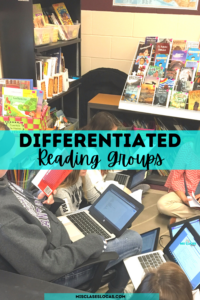
Other Novel resources you may enjoy
